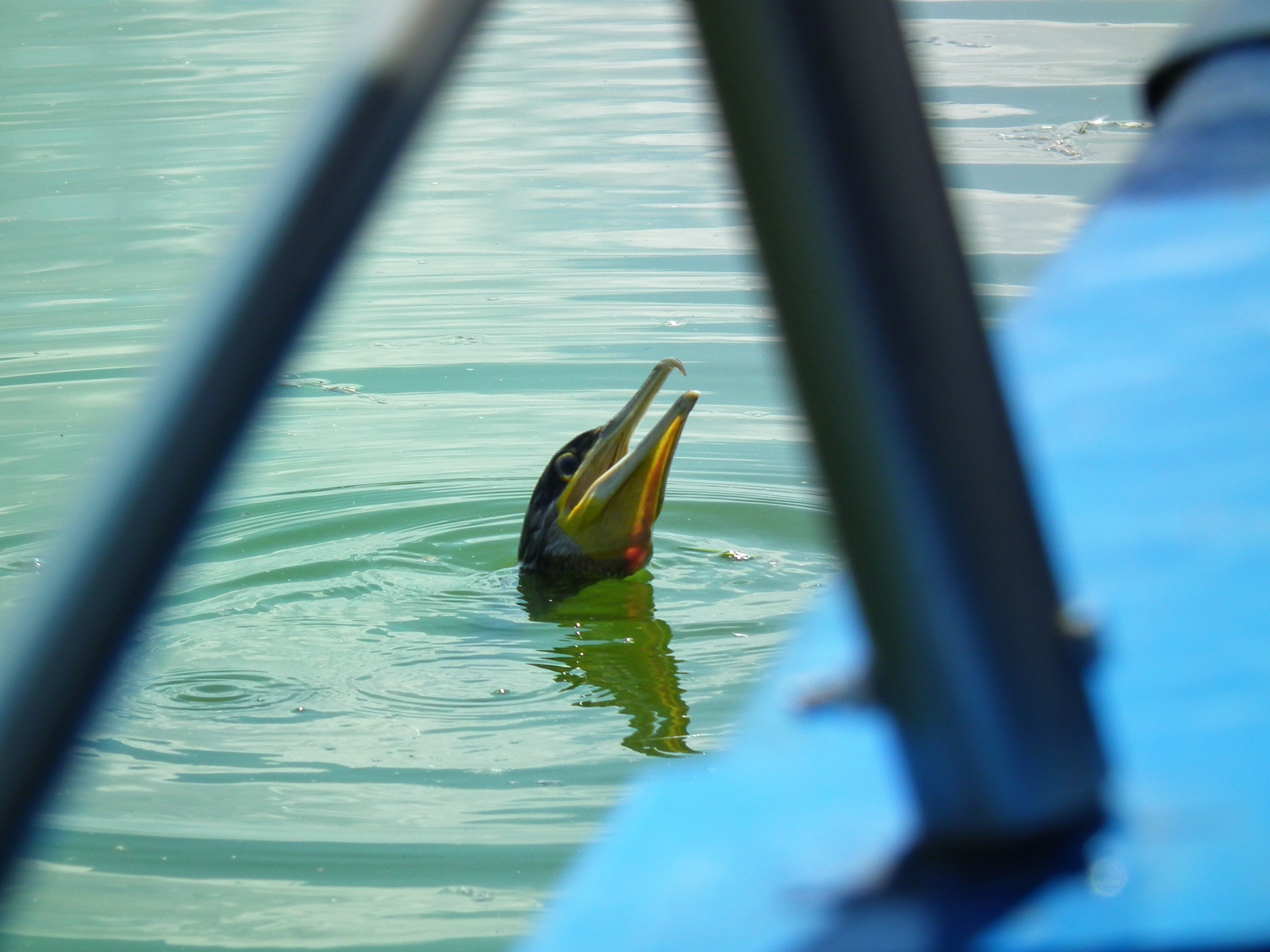
For sure, this is an odd sight, can you even imagine an agile swimmer such as cormorant drowning in the water? But let’s start at the beginning. At 6.15 am, the Sun was just rising above the distant mountain.
I was driving along the legendary eastern levee of the Kerkini Lake in northern Greece (Google Map) and, listening to the first Golden Oriole flute, was slowly getting closer to a wooded Mt. Belles, rising steeply two kilometres (1.2 mi) above the lake. The 17 km (11 mi) long lake was on my left hand side. Common Nightingales were singing, a squadron of Dalmatian Pelicans was in the air and everything was exactly where it should be, including myself.
A strange low chock chock chock call was coming from a levee-side mulberry tree. Its crown was so thick, I could spot the movement, but only rarely the bird itself and never the whole bird, once it would be only its back, once its head, once just legs… slowly, I was putting this puzzle together. Even collecting one piece after another, I didn’t manage to see the whole picture, but after a lot of effort, I collected enough pieces to ID the Eastern Olivaceous Warbler, only the first of a dozen that will be chock chock chocking from fruiting mulberries.
European Bee-eaters were now filling the sky, there was even a distant flock of Great White Pelicans, easily told apart from their Dalmatian cousins by their rosy plumage (clearly pale-rosy even at a distance; Dalmatians have a grey tinge). Several Ferruginous Duck and one surprising male Goosander, four Glossy Ibises, Common Kingfishers, Eurasian Hopooes, a high note of a Penduline Tit somewhere from the willows along the canal, Eurasian Spoonbills, European Turtle Doves gently purrring…
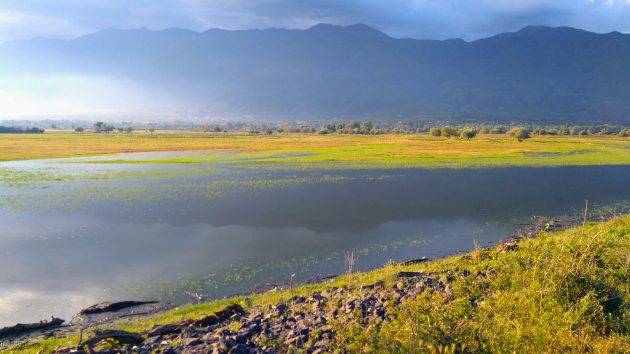
The Kerkini Lake National Park is my favourite birding area in the whole of the Balkans and while I’ve been here in April and again (migration), September (migration), October (coffee break), December and January (wintering), this was my first time in the breeding season, in May. What should I expect?
When I came here for the first time in 2014, I stayed at the Limneo B&B in the Chrisochorafa Village and met its owner, Nikos Gallios. In these five years, the hotel remained the same, only this time I met my friend Nikos Gallios.
It was Thursday when we arrived and every Thursday at Chrisochorafa square is a fish-free evening at two fish taverns. It is a popular event with the locals and the foreigners alike, where you pay for the drinks and salads, while the main dish, well prepared lake fish, is free. Different type of fish is offered in each tavern, and we opted for the first one, serving carp. Nikos looked around and commented: “There are only two tables of locals in this tavern now, all the others are foreigners. By ‘foreigners’ I mean the people from other villages.” In that count, my wife and I passed for locals. That tradition survived, but what has changed?
At mid-day, we took a boat tour of the heronries and the pelican islands with Nikos. His fibre-glass-covered wooden boat is blue as the sky. Or the lake. Or the Greek flag. The first birds to spot from the boat were Common Terns furiously defending their newly built nests on floating logs. Nikos was carefully sailing around one of them, which was almost blocking the small Mandraki harbour entry canal. “What to do now? This is my only way in and out of the harbour,” Nikos good-naturedly complained.
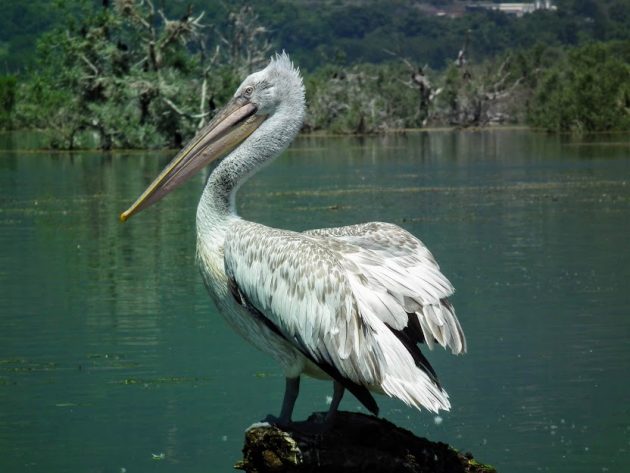 Dalmatian Pelican © Dusanka Stokovic-Simic
Dalmatian Pelican © Dusanka Stokovic-Simic
When I came here for the first time, the Kerkini Lake was the only place in Europe where Dalmatian Pelicans were increasing their numbers. They were still listed as Endangered, but wildlife management measures taken in this park were clearly working. Unlike the cormorants, much hated by local fishermen, for some reason the fishermen liked the pelicans, and even before the advent of ecotourism, when taking their nets out of the water, they would throw some fish, usually below the legal size, to pelicans that would gather around the boat. Below legal size for humans is still legal for pelicans. Over time, an unusual bond of mutual likeliness was created.
And unlike the protection of cormorants, which was perceived as a problem, protection of pelicans was welcomed by the local communities. Five years ago, I observed Dalmatian Pelicans breeding on purpose-built platforms. Nowadays, beside wooden platforms, there is an entire artificial archipelago of rocky islets created specifically for them. They have sloping sides and a flat top, meant for birds to breed on. Yet, pelicans have minds of their own, so they chose to rest and preen at the top and build nests on those sloping sides, as Dr Theodoros Naziridis, the director of the park, explained me when we met the other day.
There is one more platform, the floating concrete square anchored to a pile of rocks. Naziridis told me that they are waiting for the water level to rise enough to allow them to pull the platform further away, so the pile of rocks becomes a foundation for the new wooden platform. This year there are almost 250 pairs of Dalmatian Pelicans at the lake, with 280 chicks. Other reserves in Europe have used the lessons learned at Kerkini to successfully increase their pelican populations and therefore the Dalmatian Pelican is now downlisted as Vulnerable and is no longer Endangered.
But the success doesn’t end there: five years ago, Great White Pelicans were breeding only at Prespa Lakes National Park, 350 km to the west and commuting daily to forage at Kerkini. But nowadays, they, too, breed here, about 20 pairs this year.
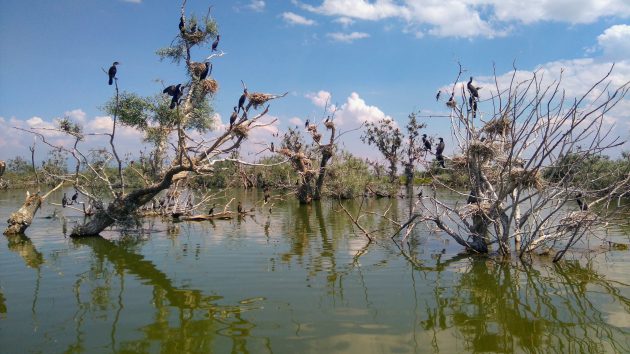
We are entering the mixed colony of 11 species (Grey, Squacco, Purple and Black-crowned Night Herons; Great, Little and, recently, Cattle Egrets; Eurasian Spoonbill (below) and Glossy Ibis; Pygmy and Great Cormorant). These visits are strictly regulated and the birds are habituated to people, showing no reaction to our presence. Nikos managed to show us the incubating Cattle Egrets, of which only 2 or 3 pairs breed in this enormous heronry, counting up to 9000 pairs back in 2014.
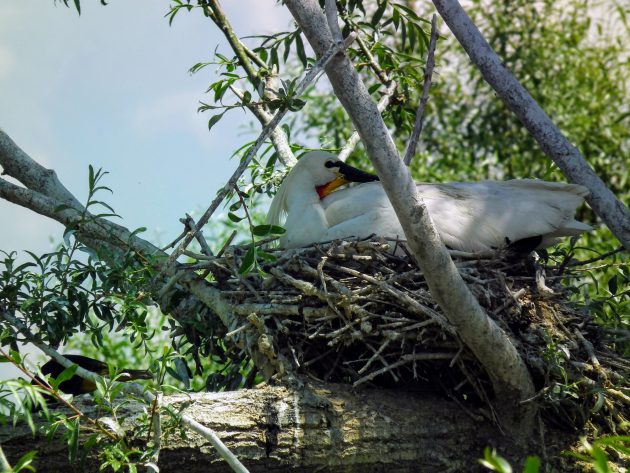
The colony is still big, as Naziridis told me, but the total number is now lower due to willows dying out without young saplings to replace them. For long it was assumed that the saplings cannot survive being under water half a year, from spring to August, but recently another theory was tested.
Asian water buffaloes were brought to Greece by Ottoman Turks centuries ago and by now, they have developed into a separate race, the Greek buffalo, which is protected as an old domestic breed. Out of some 4000 buffaloes still being kept in Greece, about 3000 are at this lake. And they both graze grass and browse younger branches and saplings.
Hence, the experiment was created: a plot was fenced off to keep the animals away and now willow saplings did survive being submerged for half a year. Three years later, when young trees were too thick for hungry bovines, the fence was moved to the next plot. While this sounds like victory, the situation is more complicated.
Naziridis explained: “In late summer, when there is no grass left to graze, some ranchers cut the fencing to let their animals into enclosures.” And the park wardens are not only ill-numbered, but also not authorised to write fines, while the police see wildlife crimes as low priority, even in a situation where most of locally paid taxes come from tavern and hotel owners, like Nikos, who depend on ecotourism for their survival. Someone should tell the police who is actually paying them.
Years ago, fishermen were complaining that Great Cormorants (counting for more than half of the total figure in the colony, up to 5500 pairs in 2014, nowadays less) have eaten all the big fish in the lake and that they can no longer catch enough fish of legal size. Naziridis, whose authority doesn’t only come from his position, but also from a fact that he was born and bred in one of the villages around the lake – so he is not seen as a ‘foreigner’, but as one of the locals – answered: “It is not the pelicans, but your illegal fishing doing the damage.” Fishing was restricted for the next three years, populations increased and the fishermen, catching big fish again, lost their cormorant argument.
Still inside the colony, I noticed a Great Cormorant barely rising its head above water, only to be pulled back under it again. Nikos has seen this before: “He’s entangled in a net.” While fishing is allowed from May 20th onward, it is prohibited to post nets inside the breeding colony. But as I said, the few park wardens are not authorised to write fines themselves, and the police thinks that they have other priorities. Nikos caught the bird by the neck and pulled it out of the water, together with a heavy net whose floats were entirely under water. The main rope was entangled around the bird’s leg, pulling it under all the time, while the thinner netting was entangled around its wings. The cormorant was visibly exhausted and if we hadn’t arrived then, in ten more minutes it could have ended under water for good. While the few lines cut into the bird’s legs, those were superficial injuries, and the cormorant was well overall: when released, it swam strongly away from our boat.
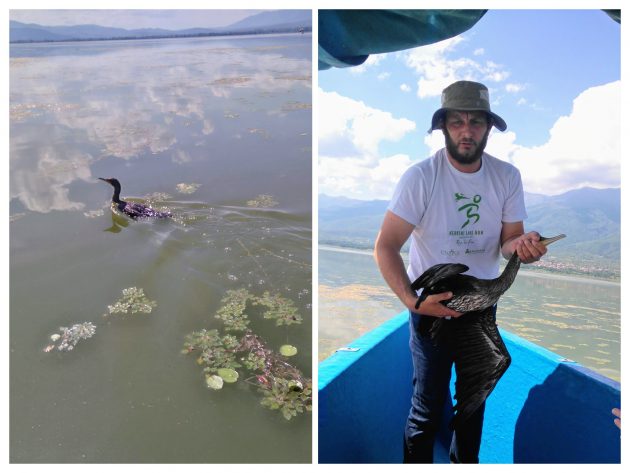
On our way back to the Mandraki, we passed the pelican archipelago once again. On the newest islet there was a flock of maybe 40 Great Whites. Beside breeding pairs, there were about 100 more non-breeding birds at this time of the year. Naziridis also said the park is applying for funds to dig a moat at the lake bottom encircling the archipelago. In mid-winter, the pelicans are here, ready to start nesting, but the water level is often low, leaving the lake bed dry and exposing their nests to terrestrial predators. The moat would protect the islets and allow the birds to start nesting earlier.
As we entered the harbour, Nikos explained the state of ecotourism in the national park: “The previous 2018 was the record year with, I estimate, about 3000 birders visiting the lake. While there is only one hotel relying entirely on birders [his “Limneo”], in the peak season [late April – early May] ten more hotels had birding groups. I know that because they did their lake tours with me. Still, there are merely half a dozen bird guides, and only one of them, Giorgios Spiridakis, resides here by the lake. There is also one bright young 16 years old birder here at the lake and I see a great future for him.”
When one thinks of ecotourism here and how it changed lives, it should be known that the locals were leaving the region, in 1960s to the USA, but in the last ten years, after the World Economic Crisis, mostly to Germany. Well-being of the birds here is intricately connected with well-being of the people. Together with buffalo meat and milk products, ecotourism – birding, butterflying, botanising; and wider adventure tourism – hiking, mountain biking, canoeing, horseback riding, is the strongest development incentive in the area (ecotourism is often lumped with adventure tourism, but I choose to split them). It brings a promise that – instead of being drowning cormorants themselves – locals can stay, work, start their families here, and attract foreign birders to their lake instead of leaving for Germany themselves.
I followed the eastern levee once again, in the late afternoon, when I had a Golden Jackal crossing it right in front of me, stopping for a few seconds to observe me. One Black Stork was feeding in the shallows (they breed in the forests of Mt. Belles). Then, there was a herd of buffaloes. Instead of slowly driving through them, I chose to stop the engine and photograph the passing animals (I should have known better from taking safaris in Africa: never turn your engine off near large animals). Should I add, there wasn’t a single good photo in the series. Yet, since I wasn’t moving, one buffalo decided that my car would make an ideal scratching post, even opted to clean its horns against me. A few yells solved the issue, but I still wished him to end in sausages sooner, rather than later.
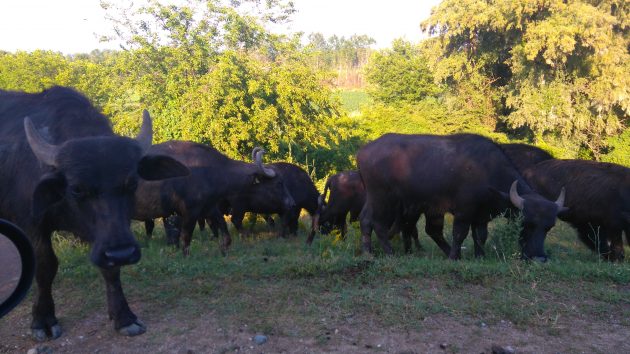
What really puzzled me then was a bird. I stopped for three Turtle Doves on the ground, lifted my binoculars to observe them through the windscreen and from the bushes a perfect silhouette of a Rufous-tailed Scrub Robin jumped out, made several jumps, cocked its tail convincingly (but remaining in the shadow of a tree crown, not going into the sunlight) and then jumped back into bushes not to show again.
I do have experience with this species from Bodrum, Turkey; it is daring, bold and cocky, and is impossible to forget. Yet, a Common Nightingale can assume the same posture, but has different proportions, a bulkier body and a shorter tail.
Interestingly, in April 2015, I was here with a group of international birding guides, at the embankment south of the Strymonas Bridge, when one of them spotted a Scrub Robin for a moment. What is the status of this species in the Kerkini NP? While it is not yet in the published, 312 species long checklist, Naziridis said: “It is possible. I saw it at the eastern dike, close to Lithotopos, several years ago, in May.” So, possible it may be, but perhaps a late migrant, because this is not a proper habitat for it? Still, having in mind how common the Nightingales are here, and Scrub Robins aren’t, I’ll be deleting it from my eBird list and keep it only in the comment. I may be more than 90% certain, but 90 is not enough. There is no 90% of a bird. It is a bird or it isn’t. 90 is “isn’t”.
The next day, still inside the national park, the lower slopes of Mt. Belles would bring me Black-headed and Cirl Buntings, and the roadside wires between Vyroneia and Neo Petritsi two European Rollers, out of only 2-3 pairs breeding in the park. Barely outside of it, the quarry near Sidirokastro rewarded me with Alpine Swifts, European Honey Buzzard, Peregrine Falcon, Eurasian Crag Martins, Red-rumped Swallows and Blue Rock Thrush. Two rather productive days, I’d say – off to the sea coast now. I’m in Greece, after all.





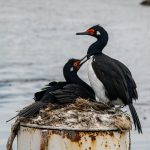
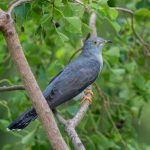
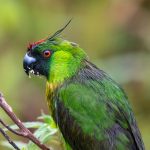

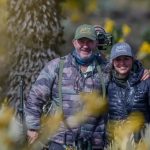
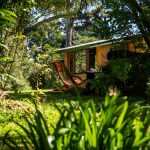
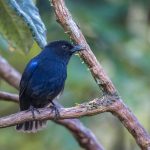
This is a really fascinating story. Thank you! It’s wonderful to learn of successful restoration projects that are changing lives for animals and people. You told the story really well, too, with all the quotes and observations.
I really have to visit this spot with you, Dragan,
I believe you said the same before, Mike. When planning trips to Europe, keep in mind that its southeast (more specifically, northern Greece, where Kerkini lies, together with neighbouring North Macedonia and southern Bulgaria) has greater density of breeding bird species than anything that can be found in the west of the continent (including often-visited Spain). Would be happy to guide you there 🙂
Thank you, Wendy. It’s nice to be able to add a touch of optimism and some good news for a change. It’s doom and gloom far too often, and environmentalists sure are prone to depression.